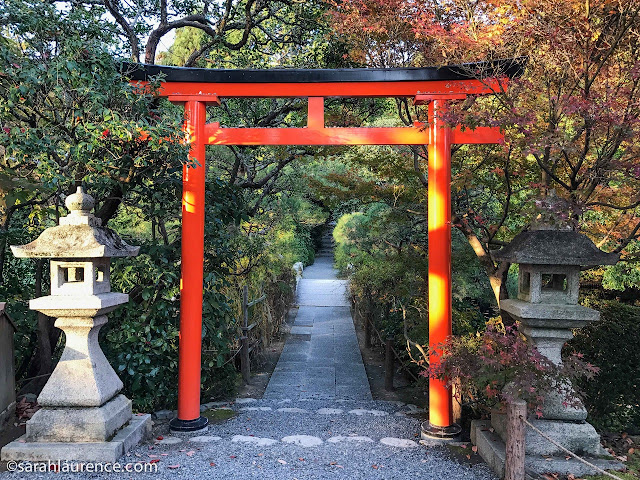 |
| Gate to Shinto shrine at Ryoan-ji Temple, Kyoto |
If you're visiting Japan, plan on several days in Kyoto if you enjoy gardens and historic architecture. This post includes only five of the 1,600+ Buddhist temples in the prefecture. Japanese temples frequently combine elements from their two national religions, like the traditional gate to a Shinto shrine (above) and the Buddhist garden (below) at Ryoan-ji Temple.
 |
| Ryoan-ji's rock garden with fall foliage. |
 |
| Ryoan-ji in April |
I have now seen Ryoan-ji in three seasons and would return a fourth time to see it in snow. That won't happen this sabbatical since my husband and I are going home to Maine for our kids' winter break from college.
Our kids were only three and six when we took them to Kyoto for cherry blossom season during my husband's last academic sabbatical to Japan. Henry teaches Japanese Politics at Bowdoin College and speaks the language but not fluently. Before he became a professor, he worked for the Bank of Tokyo in London.
 |
| Japanese maples and persimmons at Ryoan-ji |
The first time I visited Japan, I was nineteen and it was brutally hot and muggy in August. The grounds of Ryoan-ji were refreshingly cool in summer but are at their most glorious when the maples turn color. The orange fruit hanging from bare trees are persimmons, which taste like papaya when ripe.
 |
| Japanese maples at Ryoan-ji in peak foliage 11/18/16 |
 |
| Manshu-in Temple in Kyoto |
Although Japanese people usually wear western clothes, women and girls occasionally dress in kimonos to visit temples and to pray in shrines. Newlywed couples in traditional dress pose for photos too. The open porch of a Buddhist temple is designed for garden viewing and meditation. Manshu-in Temple (above and below) can't be reached by bus since the mountain village roads are too narrow.
 |
| Manshu-in rock garden 11/19/16 |
To avoid the weekend crowds, we chose two remote temples Manshu-in (above) and Enkou-ji (below). Their websites are only in Japanese. Enkou-ji is in walking distance of Manshuin.
 |
| Enkou-ji Temple in peak foliage 11/19/16 |
The summit trail offers a spectacular view of Enkou-ji Temple and Kyoto.
In the early evening, lanterns illuminate the gardens. This rock garden is not as subtle as Ryoan-ji, but the more pronounced rake patterns makes it easier to photograph.
If you're a fan of samurai movies, Daikaku-ji Temple (above and below) may look familiar.
The buildings are connected by covered walkways overlooking the inner gardens.
The screen art in the tatami rooms is exquisite too.
Daikaku-ji's outer garden has a pagoda and a lovely path around a pond.
 |
| Kinkaku-ji is also called the Golden Pavilion (photo from my April 2003 visit to Kyoto). |
People travel from all over the world to see Kyoto temples, but there are far more visitors from East Asia, especially China, than from the West. If you're visiting at a less crowded time, I'd also recommend The Golden Pavilion (Kinkaku-ji), The Silver Pavilion (Ginkaku-ji) and The Moss Garden (Saiho-ji Kokedera).
 |
| Mt. Fuji from the shinkansen. Photo by my husband (his turn for the window seat). |
Kyoto is only 2 1/2 hours by shinkansen from Tokyo. On a clear day, you can see Fuji-san from the north side of the high speed train. I can't recommend hotels since we stayed with an old friend in the neighboring prefecture of Nara. I'm considering all these locations for my novel, but I'll save Nara for another post. I don't know how I'll choose a setting among all these gorgeous options.














